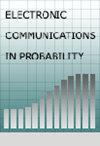蚯蚓的足迹大小
IF 0.5
4区 数学
Q4 STATISTICS & PROBABILITY
引用次数: 0
摘要
我们研究了在二维整数晶格上移动的“蚯蚓”所产生的孔的数量。蚯蚓是通过一个简单的随机漫步来建模的。在初始时刻,除了蚯蚓的位置,所有的顶点都被土粒填充。每走一步,蚯蚓就把土壤推向它运动的方向。它在后面留下一个洞(一个没有土壤颗粒的空顶点)。如果蚯蚓的前面有洞(在它的台阶方向上),最近的洞里就会填满一粒土。因此,孔的数量每一步增加1或保持不变。我们证明了在n步之后,洞的数量至少为O(n3∕4)。本文章由计算机程序翻译,如有差异,请以英文原文为准。
On the size of earthworm’s trail
We investigate the number of holes created by an “earthworm” moving on the two-dimensional integer lattice. The earthworm is modeled by a simple random walk. At the initial time, all vertices are filled with grains of soil except for the position of the earthworm. At each step, the earthworm pushes the soil in the direction of its motion. It leaves a hole (an empty vertex with no grain of soil) behind it. If there are holes in front of the earthworm (in the direction of its step), the closest hole is filled with a grain of soil. Thus the number of holes increases by 1 or remains unchanged at every step. We show that the number of holes is at least O(n3∕4)after n steps.
求助全文
通过发布文献求助,成功后即可免费获取论文全文。
去求助
来源期刊

Electronic Communications in Probability
工程技术-统计学与概率论
CiteScore
1.00
自引率
0.00%
发文量
38
审稿时长
6-12 weeks
期刊介绍:
The Electronic Communications in Probability (ECP) publishes short research articles in probability theory. Its sister journal, the Electronic Journal of Probability (EJP), publishes full-length articles in probability theory. Short papers, those less than 12 pages, should be submitted to ECP first. EJP and ECP share the same editorial board, but with different Editors in Chief.
 求助内容:
求助内容: 应助结果提醒方式:
应助结果提醒方式:


